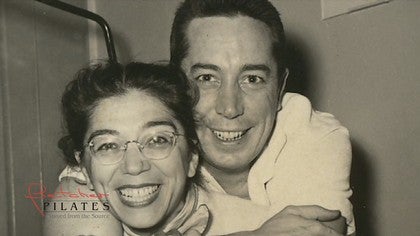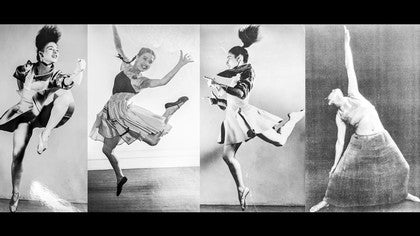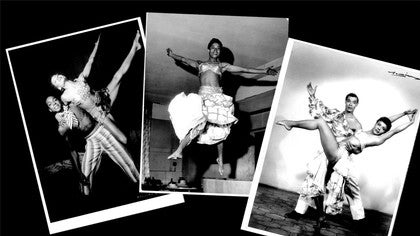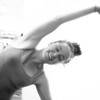Description
Kathleen Stanford Grant (August 1, 1921 - May 27, 2010) was a dancer and first-generation Pilates instructor. In addition to dancing, she has been an assistant choreographer on many projects, administrative director for the Dance Theatre of Harlem, and on the board of different programs for the arts. She is also one of only two people who was certified to teach Pilates by Joseph Pilates himself.
Kathy was referred to Joseph Pilates by dancer Pearl Lang, after knee surgery. After just a few years, she began to teach at Carola Trier's studio and then later ran the Pilates program at Henri Bendel's Department Store. At Bendel's, she taught the store's affluent patrons, as well as dancers from many companies in New York.
In 1988, she began to teach at the Tisch School of the Arts. She trained students, professional and retired dancers, and non-dancers. It was at Tisch where she developed her vocabulary for students to learn about and strengthen their bodies before doing the Pilates work. This later became known as Before the Hundred.
You can learn more about Kathy Grant by looking at her Timeline to see her many accomplishments.
The Story of My Song courtesy of Cara Reeser Pilates© 2013 All rights reserved
About This Video
Transcript
Read Full Transcript
Wow [inaudible] let's take it back there. [inaudible] your head.
Imagine yourself here. A young black girl being raised in a predominantly white neighborhood or dream is to become a classical ballet dancer. The reality in a racially segregated country is there's no such thing as a black classical dancer, but this is not something a young girl understands.
It's at this time that her career explodes and 1957 she takes a job assisting Cruela tree air and the second Palati studio to open a New York City studious and curious. Kathleen finds in Corolla yet another teacher who would go on to inspire her own creativity and healing skills. In 1964 she becomes one of the first students to be certified to teach the work of Joseph h [inaudible]. In 1965 she travels to Kaneohe West Africa with activist and performer Harry Belafonte as a cultural consultant on a special project to record film and study the music and dances throughout the country. In 1967 she becomes the director of the Clark Center for the Performing Arts in New York City.
Pioneering access to arts education and performance opportunities for minorities. In 1970 she joins Arthur Mitchell in a one year grant funded project to create the first black American classical ballet company and dance theater of Harlem was born in 1971 she's the first black American to serve on the national endowment of the arts panel. In 1972 she is invited to take over the Pilati studio at Henri Bendel's department store. It is here that she begins to develop her unique and inspired techniques for teaching what today we call the [inaudible] method. In 1983 she's invited to work as assistant choreographer on a Francis Ford Coppola movie titled the Cotton Club in the late 1980s Cathy grant, as she has come to be known in the plot, is industry moves her studio from Bendel's to New York University's Tisch School of the arts dance department.
She continues to craft her techniques and opened her heart to the countless students that flocked her classes and to her tiny studio for the next 30 years. Kathy dedicates herself to this work and to the dancers, the artists and the injured who she guides with her poetry, her hands and her grace. She gives generously and wholeheartedly teaching all of us to know ourselves, our potential, our bodies. Her work becomes a combination of an extraordinary life lead. It was never predictable to be with Kathy. Hers was a tough love, but a love that gave you what you needed to improve, to face your limitations and to surpass your expectations.
She gave us ourselves. She gave us our freedom. When Kathy died in 2010 at the age of 88 she left us with an enduring gift, the example and the wisdom of how to hold ourselves in this world. I invite you to get to know and be inspired by the extraordinary life and work of my teacher, my friend, my mentor, Kathleen Stanford Grant
Let your mind direct your body. It's really, really quiet. You got to know where your strong point is and as you get better, try and go to the weak point belly button to the lowest part of this zip tape. Measured zip tape measure, Zip, right? Perfect. You Sing my song. When you come back to center and you sing it zip belly button to the back of the waistline, put the belt down, put the best on tape. Measure it's zip and tape measures, Zip and tape measures, Zip and tape measure, right? This is how you learn to do your teaser. You end the visually have to know where your strength is.
So here we go. You individually must figure it out and don't lift it up and don't let your ego get in the way.
I can just go into the a hundred so what I've been doing is getting them strong by creating exercises before the hundred
Your head has to look straight ahead. Yes, you got to trust yourself.
I left Boston around 16 or 17. You have to remember, weren't audition for Blackfeet.
Um, Nat King Cole Lillia sound
They'd want us to be satisfied that the show was integrated as bracket. And you said, no way. It must have talked to the road because we then ended up leading that vineyards and almost went right to Europe because there was no work here. So there a lot of this kids went to your leave went because to dance the awkward or in the living in Europe much more than here being free. I think for the first time from this country is what I remember being in Europe for us was that we could go anywhere we wanted to without having to think about it to be free, but in the back of your mind, no matter where you go, you have to come back. I didn't do as much for this others because I got hurt around me.
I want you to go to Joe [inaudible]. And so I said, who's Joe Polite? That's all right. She said, he will make you dance again. You know, I thought I'm gonna go there and he's going to make me laugh like that. So when I went to him, he said, you don't know how to walk in. You don't know how to stand. And he made me walk and he criticized my walk.
And I remember him saying, Putin, you're pulling a string. You pulling a string back with bowling. And I was really very angry because that's not how I thought I was going to dance. And so I finally said to him, well, what's this has to do them? And he asked me these questions. He said, can you run for the bus? I said, oh no. You know, the big step on the bus, he said, can you make the big step? I said, no, Mr Poli and everything. He asked me, I said, no, you know, can you run up your stairs? He said, well, how can you dance if you can't do everyday ordinary things? How you expected?
You know, he would say, that's good. Yeah. Oh that's bad. Yeah. When he never said what's good or bad about it. So [inaudible] enough goods and enough bads gave you a sense of what was good to him and what was bad because he never said that bad because your head is down or that and so you, you, you remembered what the good was. Yeah. You really did. So that you can repeat it. I would stay so long. He'd say, go get out.
And I thought that was terrible because I thought the longer I stayed the better. He said, no, so much time for this and so much time for that and you don't overdue.
Please do not look at the pictures, even of a male of female and assume that were his hands are USAA. Don't do that. You're not miss the polarity. You understand what I'm saying? You look in the picture and his hand. Let's say we'll be here and you're going to struggle and your clients might be here for you. Remember that? Do not look at a picture and think his hand until your hand has to be there.
You keep fooling around with this machine until you know where you individually can push this thing down.
They don't work because when you get ready to go in that machine, if you're going to do plugs, you really, really need to get your pushups to go. It wasn't made for us. It was made for men. You've taken it over. So as I look at politeness, it's become quite feminine, but I don't want you to forget the masculinity of it. Then that's part of it. I happen to know that anatomically, we're a lot lower in the back. The most men, we have a longer back than most men. So when I say belly button to the lowest part of your waistline, you have that. You have that option. And in the time of Mr Polaris, you did from the belly button straight to the back, that was common.
It was done. I remember being political at the wall, trying to erase, trying to erase the natural curve. I have tried to bring it to what is considered today's posture, also the medical profession, etc. Etc. Etc. If Mr PyLadies power punch serves, you, don't change it. You just have an option. I don't want you to change it because I show you this. If it works, don't change it, but if it doesn't work, you have an option. When I'm teaching, I try. I don't waste my time by saying don't do that.
Don't do that. I give them something new. What I do now is with the breathing, I fine. The reason I've changed things is because more people are doing yoga and yoga, breathing and polities breathing are not compatible. So when they have yoga Palabra these, that just drives me nuts. So rather than fight the system, I give you breathing that nobody does that. It's, you don't have to compare it and you have to worry about it.
You really have to work at the Brisbane breathing into the rhythmic pattern of the, of the body. Do you use the same breathing for swimming? You do not. Do you use the same breathing for swimming that you do for, for skiing. So the breath is has to be relative to what you're doing and not just inhale and exhale all the time without a rhythmic sense of inhaling and exhaling.
You can hear that
It's absolutely they avoided. Yeah. Avoided like the play.
You can harm if you want. You can whistle if you want. I don't hear anything. What, where you shouldn't ever forget in your history of this system. Remember those who are pioneers. They may not have become famous, but they stuck to it. I want you to remember this because I don't want you to forget Corolla tree. I studied with Joe Politely, but I worked for curl chewier and Corolla Chu was the son of Mr.
Pool. Even though they teach dance history, they, they don't always include many people. They say Graham,
It's the same looking through the window, I want you to boast to remember egg and it's called thread the needles. I have certain of their
There's a little difference in the, in the, the grammar or the, the collaboration of the words and the sentences get a little lower, get it at the higher, we're going to give it a little bizarre. We're going to do the same exercise in it. I call it the Harry Bell of up a little low. We're down a little high down, a little lower up, a little high, whatever you want and down the lid. Who Lo or, and when you reach the impossible, you stay there for 30 reps. You heard me, come on, hit it. One, two, three, four, five.
Right and then kick and hold it. You're lazy and fan kicked and hold it and fan kick and hold it. No, you're going to do a slow fan kicks. Slow, slow and hold it and kick and Oh fan, kick and whole and fan kick. Hold it. That's it. I had, I always liked to tell you a little story. This woman came in and says, what is this? It's this polite. Oh, she said, I wrote a bit. Has No cardiovascular issues low.
And so black Samson listen out for black dancer. Well, the black choreographer it was doing, it was the only place that a lot of them did their first concert at Clark. Everything. Did anyone do [inaudible] but I had a good time doing things. There's a whole bunch of people that did their first concerts. That's what it was all about.
There he is. That's it. I mean, he's singing his song and he goes and he, he's really on that piano. He's born from side to side. He's having a ball. Can be a cat. It's not a question of whether you do and what I want, but it's a question of being a cat. You cannot do it right or wrong. You're either a cat or you're not, you can't. Nope. Two cats are the same. So you're not learning a movement. You are cat friendly, friendly, and with eyes. If they get to know each other, they might like each other.
You're going to write that down. There you go. See, so you have so many images can be creative or you can be practical.
But when I want to get to this so much more is that that studio with with the influence of politeness was a place of kindness. Even if you have different political views. It helped me and it helped them to get through. And I think if anything that I have done is that that Joe Pilati studio was open to all races, religions, political views and so forth. And uh, and that also goes, I think in the work itself.
He always said, if you can't, you know, if you can't change mentally, you cannot change fits within that something which I try and pound out to people. We also didn't work this exclusivity that you all do one-on-one. However, when I went to him as an engine person, there was the one on one and he had a separate place. And then as you got better, I then went into the main studio, which is the way I work now. I don't know whether it's right or wrong, but that's where I was introduced to fly from a one on one situation because of an injury and then to the big studio to learn the other things.
She does the footwork on the reformer. She does the Jack Knight. Yes. So let Alison do the Jack Knife up there and I'm [inaudible] Oh, she can do the arm chiefs, so therefore you can do that. But no, no. Put The ball in your Chin and then rolled down shoulders. That's it.
I'm going to take an engine foot.
These are the little things that I've learned to do an intuition. If I see him cringe, I want to know why he's cringing. That's it. Now bring your legs towards that. That pole. Go ahead. You got it. You got it. You have it. You have it. See that strength because this is strong. Breathe through the sternum bone, the yellow room. Come on, let the breath come down. When you get to you, you start the ball breathing.
See, come on down. Easy. See the ball breathing open sis. It's the only breathing. I swear to you that will bring you down without dropping because if it spread, go ahead. How aware are you? What else do you have to call? Oh, okay.
So everything is, I just say no. Basta enough. Let's have some fun, bumped and boom and boom, boom. That's it. That's it. That's it. That's it. That's it. There's nothing wrong with your foot. Well bye bye. Bye. Doesn't that foot feel better? Bye.
I liked the stretches, but that takes time. I think we ought to leave the stretches out. The stretches out. Yes. I think you're right. You understand what I'm saying? I think we the NFI forget you just, we're gonna do the building. Meg's okay. And then we're gonna go right into the turnout. We have to go down street
You're going up a hill. How can you go up a hill unless you pull? Stretch it like springs. Bring your head up in the direction of the hill. Put your hands on your head. Squeeze your fist tight, right. Hold onto the right leg with both hands stretched up to the ceiling. The left leg is one foot from the ground. Lower for the single leg.
Straight stretch. Paul. Paul Changed Paul. Paul Changed Paul. Paul changed heading forward. Head before a gym. Ball under the Chin and stretch. Really stretch, stretch, nice straight like straight leg straight, very lovingly without sticking your butts out, you're going to come up. You know [inaudible]. You are not going to stick the butts out. You got Quads, you've got dominant muscles, you've got everything. Use it. Now's the time to put it all together.
We're getting ready to do the a hundred here we go. And Inhale, put the ball in your Chin and exhale, don't pan again. Inhale straight on. Don't panic. Rapid a little bit more and inhale. That's it. No shoulders. Exhale. I'm going to cut it soft because of the time. Exhale. Bend your knees and put your head down.
Extend the legs on the floor. Relevate second position in the arms. You know what you're doing. Now you know what you're doing by this time belly button to the lowest part of the waistline, right? I don't want the bikini, but this is where we don't use it. You have the tape measure. You have your belt. You bring the arms up under our muscle under arm, under arm. Thank you. Heels down sloppily.
Open the arms. Exhale, tell me something. Yes. Thank you God.
Now inhale with the stomach in ladies and lower the back just to right. No. Inhale and come up with an exhale. It's not making [inaudible]. Inhale and exhale low. Keep the stomach in. That's it. You got it. You didn't. Hell. Exhale. That's it. That's it. That's it. That I love you all. You see how easy it is?
It's time for me to go then. Pretty soon. Yeah. Okay, you're ready. Lift up. One, two, take good. Down the leg. Sweet. Counts up to three. Take it down to three. Take it up to three. Take it down. Two pots together. Lift up. One, two, three. Hold it for hold it five. Hold it. Six Oh seven take it down to three. Lift.
One, two, three. Hope good. Kick. Hey, and stay there. Come on up. Get those elbows up. You can do it in our thighs. Perfect. Not Bad.
There's no tension in your body. You are a shape, not a human shape. Look at your shape in the palm of your hands. Very jazz move. Allow your shape to float down towards the earth. Let your shape flow downward down, down.
Your shape has lost its shape, but it hasn't lost its energy. So therefore, take another shape and let it float gently towards the sky gesture. Towards this day, you can think of snow falling. You can think of rain rolling down the window pane. Allow your shape to float downward just before it touches the earth.
It takes another black [inaudible]. It doesn't really state, it just keeps moving.
[inaudible]. [inaudible]. [inaudible]. [inaudible].
Pilates Legacy Project: Biographies
Comments
You need to be a subscriber to post a comment.
Please Log In or Create an Account to start your free trial.
































































